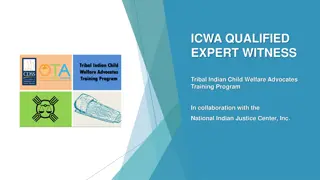Stone Child College: Empowering Tribal Education with Excellence
Stone Child College, located on the Rocky Boy's Indian Reservation, serves the Rocky Boy community with accredited degree programs and educational opportunities. Established in 1984, the college focuses on preserving tribal languages, cultures, and histories while preparing students for a successful future. With a mission of academic excellence and commitment to cultural heritage, Stone Child College embodies the core values of education and community development.
Download Presentation

Please find below an Image/Link to download the presentation.
The content on the website is provided AS IS for your information and personal use only. It may not be sold, licensed, or shared on other websites without obtaining consent from the author.If you encounter any issues during the download, it is possible that the publisher has removed the file from their server.
You are allowed to download the files provided on this website for personal or commercial use, subject to the condition that they are used lawfully. All files are the property of their respective owners.
The content on the website is provided AS IS for your information and personal use only. It may not be sold, licensed, or shared on other websites without obtaining consent from the author.
E N D
Presentation Transcript
STONE CHILD COLLEGE Created By Dr. Kadene Drummer
Located on the Rocky Boy s Indian Reservation Box Elder, MT 59521 Rocky Boy's unusual name came about from a mistranslation of the name of a tribal leader, whose name meant something akin to "Stone Child".
Profile 26 miles south of Havre (population 12,000) Over 6,000 enrolled tribal members Stone Child College chartered on 5/17/1984 Granted full accreditation in June 1993.
Stone Child College Student Population Served 2008-2009 2009-2010 2010-2011 1,188 1,199 734 Fall 2011 Current enrollment on Aug. 30, 2011 is 268 with one week to still add.
Mission Stone Child College (SCC), a tribally controlled community college, exists to deliver post- secondary education in the Rocky Boy Community. SCC will provide student access for educational training needs through accredited certificates and degree programs for transfer, workforce entry, continuing and developmental education.
Vision "Making our Dreams Happen with Academic Excellence, Culture and Commitment"
Core Values Preserving the Past, Educating the Present, Planning for the Future
Guiding Principles To provide further specificity to the Mission Statement, the SCC Board of Regents has committed the college to the following principles: Preserve and promote the languages, cultures, and histories of the Chippewa Cree. Assist tribal organizations in staff development, planning, research, and other needed services.
Guiding Principles continued Collaborate with other institutions and agencies in furthering the interests of the college and community. Continually assess institutional programs and student achievement for increased efficiency and effectiveness.
Guiding Principles continued Maintain a student-centered, life- long learning oriented environment, including opportunities for leadership and community service.
Associate of Arts Degrees Early Childhood Education Elementary Education Health & Physical Education Health Promotion Industrial Technology Industrial Technology Education Liberal Arts Math Native American Studies Natural Resources Studio Art Water Quality Addiction Studies Native Communities Psychology
Associate of Science Degrees Certificate Programs Accounting - 1yr Construction Tech. - 1 year Customer Relations - 1 year Physical Fitness - 1 year Pre-Engineering - 1 year Pre-Nursing - 1 year Allied Health General Science General Business Office Administration Information Systems
Challenges in Programmatic, Planning and Strategic Efforts to Increase Graduation and Retention Rates Below national (27.5%) and Montana (29.7%) two-year graduation rates with SCC being at 7%.* Below national (52.5%) and Montana (45.8%) first-time college freshman returning their second year with SCC being at 40%.* *data from 2008 National Center for Higher Education Management System-Retention Rates
Resource Challenges Reported by students from Chippewa Cree Tribe Students need longer daycare facility hours to allow for required class time and study hours. Students need a calendar that recognizes cultural and community events. Students need an inexpensive place to purchase meals on campus. Students need a staffed writing lab/learning center. *data from Dr. Drummer s 2009 research
Resource Challenges Reported by students from Chippewa Cree Tribe cont. Students need a work space/resource room that contains supplies and tables for the purpose of completing course work.* Students need access to academic clubs and opportunities to enter competitions without having to be completely financially responsible for travel and registration.* *data from Dr. Drummer s 2009 research
Programmatic Challenges Reported by students from the Chippewa Cree Tribe Programs/initiatives that focus on improving student persistence, responsibility, preparation for the transition from high school to college. Course on study skills and time management. Transition programs/clubs that address the student s willingness to leave their comfort zone and develop their social skills, study skills, and class attendance and preparedness. *data from Dr. Drummer s 2009 research
Programmatic Challenges Reported by students from the Chippewa Cree Tribe cont. Collaborations with K-12 schools and the community to develop programs that encourage early preparation for college. Awareness of Native American centers on campuses and professional development seminars on cultural diversity. Increased faculty and student interactions. Create an advisory committee charged with increasing student retention. *data from Dr. Drummer s 2009 research
Programmatic Challenges Reported by students from the Chippewa Cree Tribe cont. Recognize and award student success. Develop a comprehensive college finance and budgeting workshop that includes the whole family. Develop and maintain a data base to collect educational and cultural issues data. *data from Dr. Drummer s 2009 research
In Conclusion: The SCC Retention Committee, college administration, and faculty have a great desire for our students to succeed. We are committed to continue to work diligently to increase the retention rate of our students. We are seeking smarter ways to reach this goal. We are pleased to be part of this Student Success Collaborative in the hope of gaining information to implement successful practices.
Thank you for your attention and we welcome you to visit anytime.























